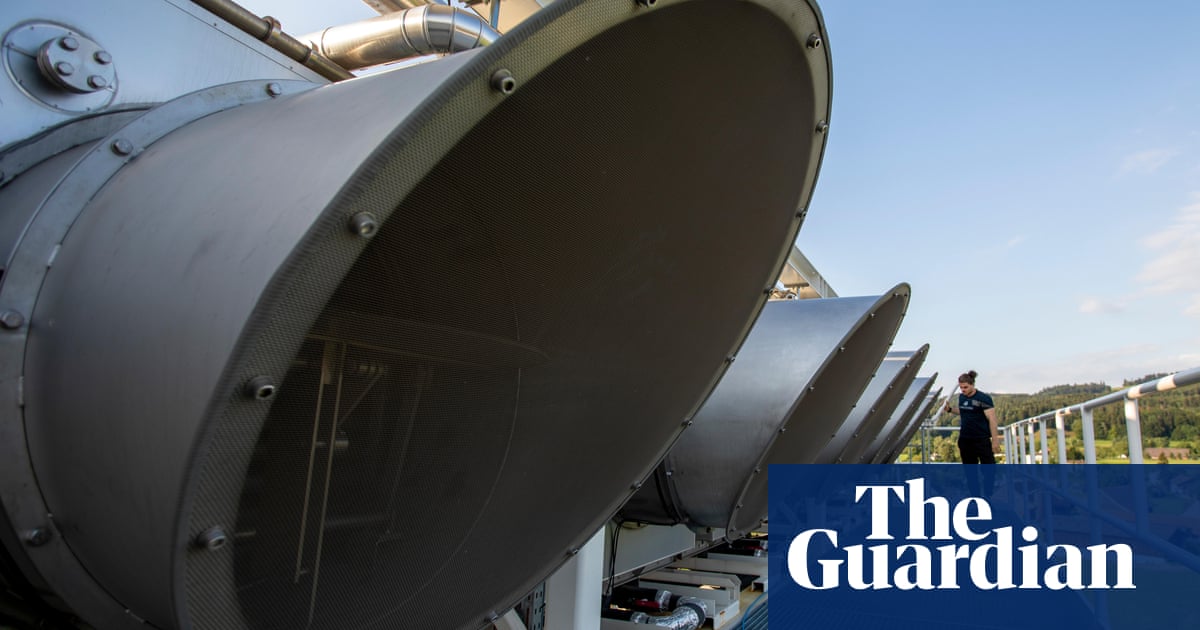A Swiss startup that has led the way in sucking carbon out of the air has announced plans to cut its workforce by more than 10% amid economic uncertainty and “reduced momentum” for climate tech.
The downsizing at Climeworks, the company that built the world’s first direct air capture facilities, comes one week after journalists in Iceland revealed itstwo flagship plants have captured far less carbon than their advertised capacity. A spokesperson said the timing of the redundancies was unrelated.
“We’ve always known this journey would be demanding,” said CEOs Christoph Gebald and Jan Wurzbacher in a joint statement about the job losses on Thursday. “Today, we find ourselves navigating a challenging time.”
Climeworks attributed its decision to economic issues hitting the whole industry. The company, which is now in a consultation process required by Swiss law when more than 10% of a workforce is at risk, said it was also influenced by uncertainty about a third facility planned for the US, where President Donald Trump has repeatedly attacked policies to cut pollution and pushed toscrap incentives for clean energy projects.
Direct air capture is one of the most expensive forms of cutting carbon concentrations but has increasingly gained traction among companies seeking more credible ways to compensate their emissions than traditional offsets – which analyses have repeatedly found to be riddled withjunk projects. In recent months, Climeworks has signed deals to permanently remove carbon dioxide from the atmosphere with Morgan Stanley, TikTok and British Airways.
But the technology is still struggling to grow out of the pilot phase. The Icelandic investigation found that both plants had drastically underperformed on their promises. The company’s flagship Mammoth plant in Iceland, which has a nameplate capacity of 36,000 tons of carbon dioxide a year, captured 750 tons in the first 10 months since opening, according to Climeworks, with net removals after accounting for emissions in the supply chain coming to just 105 tons. The carbon savings amount to as much as eight average Americans will have emitted over the same period.
The smaller and longer-running Orca plant, which is designed for net removals of 3,000 tons per year, has failed to reach 1,000 tons of net removals in any year since it began operations in 2021.
While pilot projects should be expected to struggle and even fail in some ways, the scale of the undercapturing is surprising, said Mark Preston Aragonès, a carbon accounting analyst at environmental group Bellona, who visited the facilities for the launch of the Mammoth plant.
“The mistakes I would link to hype and not managing expectations,” he said. “They have themselves to blame, but also the market actors that were kind of egging them on.”
Climeworks initially said it could get the high costs of direct air capture down to $100 per ton of carbon by 2030 – the “holy grail” for carbon removal companies – but the company has since scaled that ambition back to $250-350 per ton. The cost of the energy-intensive process today is roughly triple that.
A spokesperson for Climeworks said both of its plants in Iceland had delivered valuable progress, with Orca having steadily improved over years while the newer Mammoth was still in a “ramp-up phase” that doesn’t reflect its full potential.
“As it often goes with any new infrastructure, we’ve encountered early mechanical issues that we’re actively addressing with upgrades already under way,” the spokesperson said.
Carbon dioxide removal is considered a key tool in scientific roadmaps to keep the planet from heating 1.5C (2.7F) by the end of the century, both to compensate for residual emissions and to bring temperatures down after a likely period of overshoot, but critics have argued that direct air capture will increase emissions if it is powered by fossil fuels and strain limited renewable resources if run on clean energy. Some scientists have also grown alarmed by companies touting carbon removal asan alternative to getting rid of fossil fuels, rather than an add-on that makes sense once cheaper levers have been pulled.
Sign up toDown to Earth
The planet's most important stories. Get all the week's environment news - the good, the bad and the essential
after newsletter promotion
“The fortunes of carbon dioxide removal startups will go up and down over time, but this is a sharp reminder that the only show in town for the next decades is to reduce emissions,” said Glen Peters, a climate scientist at Cicero research institute in Norway.
To reduce the risk that the promise of future removals will deter companies and governments from cutting pollution today, green groups have called on the EU to separate out its net zero targets into categories for reductions and removals.
“The only way in which direct air capture can really make sense … is if the rules are so tight that it’s the only option you have left,” said Aragonès.
He compared efforts to reduce carbon pollution in the atmosphere to a person trying to stop a bathtub from filling up.
“We’re not creating the right framework to close the tap, nor to open up the valve,” he said. “And opening up the valve is much more expensive than closing the tap, so it’s obvious that those who work on removals are having more challenges than those who work on reductions.”
